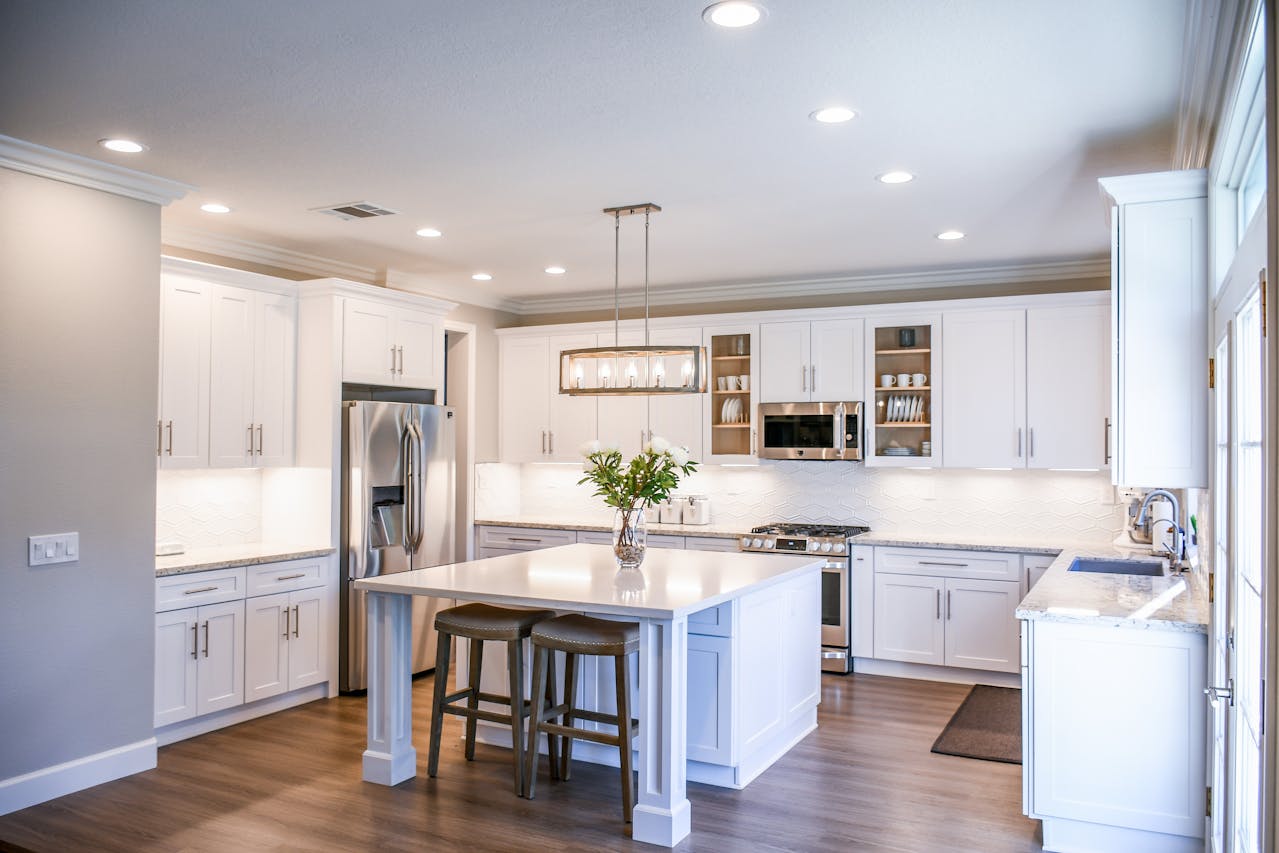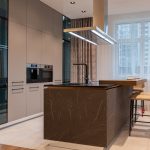The kitchen is the heart of a home, and it’s a space where form and function should harmoniously co-exist. Creating a functional kitchen does not mean compromising on design. In a world where simplicity and ease of use are highly valued, a minimalist kitchen design brings together style, space, and functionality. The challenge is to combine these elements in a way that creates a sleek, modern look without losing the practicality that a kitchen demands. The primary elements we will be considering include cabinets, lighting, color, and appliances. This article will guide you on how to achieve a minimalist kitchen with maximum functionality.
The role of cabinets in minimalist kitchen design
When it comes to achieving a minimalist kitchen design, cabinets play a crucial role. They are not just storage units but significant aspects of the interior design. When you think of minimalism, think of functionality with an aesthetic appeal. This means that your cabinets should not only provide adequate storage but also contribute to the overall look of your kitchen.
Also to read : How can you maximize counter space in a small kitchen layout?
Choose cabinets with clean lines and simple designs. Opt for handle-less cabinets for a sleek, clean look. The color of the cabinets also contributes to the minimalist design. White cabinets are a popular choice as they create an illusion of more space while giving the kitchen a fresh, clean look. However, you should not feel limited to white. Neutral tones like beige, grey, or black also work well, depending on the overall color scheme of your kitchen.
Remember the key to minimalism is reducing clutter, so consider cabinets that stretch up to the ceiling to maximize storage space. Additionally, hidden storage solutions like pull-out drawers and built-in spice racks can help maintain a clutter-free countertop.
Also to read : What are the latest trends in coffee station setups in UK kitchens?
How to use lighting to create a minimalist kitchen
Lighting is a critical element in kitchen design. It is not only functional but also has a significant impact on the ambiance of the room. In a minimalist kitchen, lighting should add to the room’s clean, modern look while still providing adequate illumination for various kitchen tasks.
One way to achieve this is through recessed lighting. These fixtures are installed into the ceiling, so they don’t distract from the minimalist look. Place them strategically around the kitchen to light up your workspace effectively. You can also add under-cabinet lighting to illuminate the countertop area.
Pendant lights are also a great way to add a style statement in a minimalist kitchen. Opt for designs with clean lines and neutral colors. These lights can be used to highlight a specific area, such as an island or a dining table.
Choosing the right appliances for a minimalist kitchen
Appliances are essential for a functional kitchen, yet they can often disrupt a minimalist aesthetic. However, with careful selection and placement, you can incorporate appliances into your kitchen design without compromising on the minimalist style.
Choose appliances with a sleek, modern design. Stainless steel appliances are a popular choice, but if you want to maintain a uniform look, consider appliances that can be integrated into your cabinetry. This means your refrigerator, dishwasher, and even your oven can blend in with your cabinets, contributing to the clean, uniform look.
When it comes to small appliances like coffee makers, toasters, or blenders, consider the frequency of use. If you use them daily, find a spot on the countertop where they can live without creating clutter. For infrequently used appliances, create a dedicated storage space where they can be tucked away when not in use.
The importance of color in a minimalist kitchen design
Color plays a significant role in creating the desired atmosphere in any room. In a minimalist kitchen, color can help enhance the feeling of space and serenity. White is a common choice for a minimalist kitchen as it creates a light, spacious, and serene environment. It’s a classic color that never goes out of style.
However, a minimalist kitchen is not limited to white alone. You can also opt for other neutral colors like grey, black, or beige. If you love color, consider adding subtle pops of color through kitchen accessories or a single feature wall. The key is to keep it simple and not overwhelm the space.
Maximizing kitchen functionality in a minimalist design
While the minimalist design focuses on simplicity and minimal décor, functionality is just as important. It’s crucial to maintain a balance between the two, ensuring your kitchen is a practical space for cooking and dining.
Consider your kitchen layout carefully to ensure a functional workspace. The "kitchen triangle," which connects the sink, stove, and refrigerator, should be clear of obstructions for efficient cooking. Also, consider the placement of your cabinets and appliances to allow for easy movement.
Lastly, don’t forget about the practical aspects such as the size and number of appliances, storage space, and the materials used. For example, solid surface countertops are a good choice for a minimalist design due to their durability and easy maintenance.
Achieving a minimalist kitchen design without sacrificing functionality is all about balance. By focusing on these key elements – cabinets, lighting, appliances, color, and functionality – you can create a kitchen that’s not only stylish and modern but also a joy to cook in.
Incorporating open shelving and storage solutions in a minimalist kitchen
Open shelving is a modern kitchen design idea that’s gaining popularity. It adds an airy and open feel to the kitchen, creating an illusion of a larger space, a critical aspect in a small kitchen. Properly executed, open shelving can significantly contribute to achieving a minimalist kitchen design.
One way to incorporate open shelving into your minimalist kitchen is by using them as a replacement for upper kitchen cabinets. This gives you easy access to everyday items like dishes and cups, which can be neatly arranged on the shelves. Floating wooden or metal shelves add a touch of simplicity and elegance to the kitchen.
Not all items, however, are suitable to be kept on open shelves. That’s where storage solutions come into play. To maintain a clutter-free kitchen, consider installing pull-out drawers, Lazy Susans, and built-in spice racks to keep your items organized and out of sight. Dividing your drawers into sections can also help you keep track of your utensils and cutlery.
One more thing, don’t forget to factor in the maintenance. Open shelves may require regular dusting and cleaning, and organizing the items kept on them can also be a regular task. Therefore, it’s crucial to strike a balance between open shelving and closed cabinets based on your lifestyle and preferences.
Using natural light and design ideas to enhance the minimalist kitchen space
The use of natural light can make a huge difference in creating a clean and fresh environment, a key aspect of a minimalist kitchen. Large windows allow plenty of natural light to flow in, giving the kitchen a bright and airy feel. If it’s not possible to have large windows, consider installing a skylight, which could add more light to your kitchen space.
Besides, using a light color scheme can help reflect light, making your kitchen appear larger and more open. Mirrors and glossy finishes can also be used to reflect light and make the space look larger.
However, your minimalist kitchen should not just be about aesthetics. It should also be a practical and functional space. Consider adding a kitchen island if you have the space. A kitchen island serves multiple purposes – from providing additional workspace to serving as a dining area. It’s also a great place to install your cooktop or sink.
In a minimalist kitchen, the kitchen island should have clean lines and a simple design. You can also use it to add a subtle pop of color to your kitchen. Pendant lights above the kitchen island can add a modern touch and improve the overall lighting of your kitchen.
Conclusion
Creating a minimalist kitchen design does not mean that you have to compromise on functionality. By carefully considering the elements of interior design, such as cabinets, lighting, color, and appliances, you can achieve a sleek, modern kitchen that is not only beautiful to look at but also a joy to cook in.
Incorporating open shelving can enhance the minimalist style by creating an airy, spacious feel. Meanwhile, efficient storage solutions help keep your kitchen clutter-free and organized. Natural light and a light color scheme can make your kitchen seem larger and more welcoming, while a practical kitchen island can add functionality to your kitchen space.
Remember, balance is key in achieving a functional minimalist kitchen. An efficient layout, practical materials, and careful selection of appliances can ensure your kitchen is a practical space for cooking and dining. With these design ideas, you’re well on your way to achieving a stylish, functional, and minimalist kitchen.






